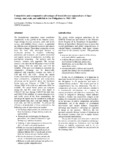Competitive and comparative advantages of brackishwater aquaculture of tiger shrimp, mud crab, and milkfish in the Philippines in 1985-1995
- Global styles
- MLA
- Vancouver
- Elsevier - Harvard
- APA
- Help

View/
Date
2007Author
Page views
7,279ASFA keyword
AGROVOC keyword
Taxonomic term
Metadata
Show full item record
Share
Abstract
The brackishwater aquaculture sector contributes considerably to the growth of the fisheries sector. Tiger shrimp Penaeus monodon, mud crab Scylla serrata, and milkfish Chanos chanos, in particular are efficient users of domestic resources and earners of foreign exchange. These three commodity sectors have not been fully developed because of inadequate policies in research, technology generation, and extension, and in public investment and support services in production, marketing, and post-harvest processing. Our analysis used the domestic resource cost approach. The average resource cost ratios for the Philippines were 0.44 for tiger shrimp, 0.66 for mud crab, and 0.35 for milkfish. If the peso overvaluation is corrected, the comparative advantage can be dramatically enhanced with respective resource cost ratios of 0.36 and 0.55, and 0.28. Given the current international market and production technologies for these commodities, competitive and comparative advantage can be sustained above the breakeven border price per kilogram of US$6–7 for tiger shrimp, US$5–6 for mud crab, and about US$1 for milkfish. The actual border prices per kilogram during the past five years have been higher at US$12.34 for tiger shrimp, US$8.39 for mud crab, and US$2.39 for milkfish. At current domestic costs and border prices of the these commodities, the advantage in exports may be sustained at yields per hectare greater than about 2 mt tiger shrimp, 100 kg mud crabs, and 500 kg milkfish. To enhance the efficiency of production of these commodities, the following areas of intervention are needed:
- Technology improvements in seed production from the hatchery of tiger shrimp, mud crab, and milkfish
- Research and technologies for diagnosis, prevention, and control of diseases of tiger shrimp (e.g. luminous bacteria)
- Training in farm management to enhance the skills of small-scale pond operators
- Public investments in infrastructures and support services including credit access to enhance efficient flow of goods and services from the farm to strategic market outlets
- Market development to ensure sustainable outlets for brackishwater pond production
- Reforms in trade and exchange rate policies to enhance global competitiveness
Suggested Citation
Gonzales, L. A., Elca, C. D., Gonzales, V. A., Alviola IV, P. A., Paraguas, F. J., & Olalo, C. (2008). Competitive and comparative advantages of brackishwater aquaculture of tiger shrimp, mud crab, and milkfish in the Philippines in 1985-1995. In T. U. Bagarinao (Ed.), Research Output of the Fisheries Sector Program (Vol. 2. Reports on Fisheries and Aquaculture, pp. 213-234). Quezon City, Philippines: Bureau of Agricultural Research, Department of Agriculture.
Type
Book chapterISBN
9718511776
Related items
Showing items related by title, author, creator and subject.
-
[The Philippines recommends for milkfish:] Pond culture
Corre Jr., Valeriano L.; Saclauso, Crispino A.; Garcia, Yolanda T.; Salayo, Nerissa D.; The Milkfish Technical Committee 2016 (DOST-PCAARRD, 2016) -
Grow-out of milkfish in net-walled marine pens in La Union
Domenden, Nestor D. (Bureau of Agricultural Research, Department of Agriculture, 2007)Grow-out of milkfish in 125 m2 net-walled marine pens was tested in Santo Tomas Cove, La Union at three stocking densities of 6, 9, and 12 fish/m2 and using commercial feed (crumbles and pellets) with ... -
An economic analysis of the modular pond system of milkfish production in the Philippines
Agbayani, Renato F.; Baliao, Dan D.; Franco, Nilo M.; Ticar, Romulo B.; Guanzon, Nicolas G., Jr. (Elsevier, 1989)In 1980, the annual yield of milkfish ponds in the Philippines was 800 kg/ha while the potential yield is estimated to be 2000 kg/ha. The modular pond system analyzed in this study can largely close the gap between actual ...





